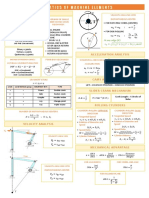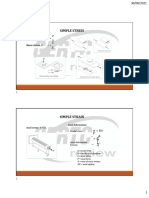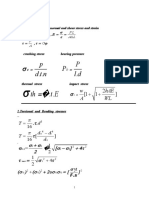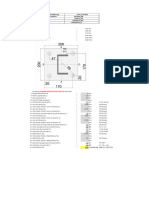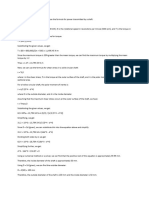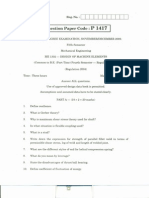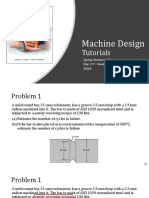0 ratings 0% found this document useful (0 votes) 18 views 33 pages DME
The document outlines the design process for a ball bearing suitable for an axial flow compressor, including calculations for dynamic load capacity and selection of a bearing that meets the required specifications. It also details the design of a helical spring, a cantilever welded plate, and a knuckle joint, providing formulas and steps for determining dimensions and stresses. Finally, it discusses the advantages and disadvantages of welded joints compared to riveted joints.
Copyright
© © All Rights Reserved
We take content rights seriously. If you suspect this is your content,
claim it here .
Available Formats
Download as PDF or read online on Scribd
Go to previous items Go to next items
Design a suitable ball bearing for an axial flow
compressor to carry a radial load of 2.5 KN and
a thrust load of 1.3 KN. The service imposes a
light shock with shock factor 1.5 and bearing
will be in use for 35 hours per week for 4 years.
The speed and diameter
of shaft are 900 rpm and 45 mm respectively,
Assume X = 0.56 and Y= 1.4,
To design a suitable ball bearing for an axial flow compressor carrying both
radial and thrust loads, we need to determine the dynamic load capacity
(C) of the bearing using the L10 life equation.
Given Data:
+ Radial load, F, = 2,5kN = 2500N
+ Thrust (axial) load, , = 1.3kN = 1300N
15
+ Shock factor, Ky
+ Speed, N = 900rpm
+ Shaft diameter = 45 mm (used for dimensioning later)
+ Life: 36 hours/week for 4 years
+ Life in hours: 35 x 52 x 4 = 7280 hours
0.56, ¥ =
+ Equivalent load factors:
Step 1: Calculate Life in Revolutions
Ly = 60 x N x life (hours) = 60 x 900 x 7280 = 393, 120, 000 rev
Step 2: Calculate Equivalent Load F,
Use the equivalent load equation:
FE
K,-(XF.+¥R)
1.5 - (0.56 - 2500 + 1.4- 1300) = 1.5 - (1400 + 1820) = 1.5- 3220
Step 3: Use the L10 Life Equation to Find Dynamic Load
Capacity (C)�F, = 1.5 + (0.56 - 2500 + 1.4 - 1300) = 1.5 - (1400 + 1820) = 1.5 - 3220
Step 3: Use the L10 Life Equation to Find Dynamic Load
Capacity (C)
For ball bearings:
a
Ly = a) scr 1if
C = 4830 - (393, 120, 000)"/*
First, compute the cube root:
(393120000) ~ 732
Now calculate C:
C = 4830 x 732 = 3,537, 560N ~ 3.54kN,
Step 4: Select a Suitable Bearing
Choose a deep groove ball bearing with C = 3.54 kN and bore diameter =
45 mm. Referring to a standard beering catalog (like SKF or FAG), one
option is:
* Bearing 6209 (Deep groove balll bearing)
* Bore: 45mm
+ Dynamic Load Capacity (C): ~27.9 kN
* Static Load Capacity (C,): ~15.6 kN
This bearing exceeds the required C, so it is a suitable choice.
Final Recommendation:
Bearing Selected: SKF 6209 (or equivalent)
Reason: Meets required dynamic capacity (C 2 3.54 kN), fits shaft diameter,
and suitable for combined radial and thrust loads with light shock.
Would you like a diagram or table to show the bearing specs clearly?
ab @Ww Be By�sainiinateitiaiit atiek jiciie il tain iaretae liane
diameter and is of outside diameter 75 mm. The
spring has 6 numbers of active coils, If the
permissible stress in shear is 350
N/mm? and the modulus of rigidity is 84
knymme,
. find the axial load, which the spring
can take and also the deflection produced.
‘To solve this helical spring problem, we will calculate:
1. The maximum axial load the spring can take based on permissible
shear stress
2. The deflection produced under that load
Given:
+ Wire diameter, d = 8mm
* Outside diameter, D, = 75mm.
+ Number of active coils, n = 6
+ Permissible shear stress, 7 = 350N/mm?
+ Modulus of rigidity, G = 84kN/mm? = 84,000N/mm?
Step 1: Calculate Mean Coil Diameter
D=D,—d=75-—8= 67mm
Step 2: Calculate Spring Index C’
Step 3: Wahl's Correction Factor I
Wah''s factor accounts for curvature effects:
4C-1 + 0.615 4-8375—-1 0.615
40-4 Cc 4-8.375-4 8.375
0.615 31.5
ao = 40.0734 = LU .0734 = 1.1784
3375 ~ 285 + 0.073: 05 + 0.073: 78:
v�Step 3: Wahl's Correction Factor K
Wahl's factor accounts for curvature effects:
K-= 4C—-1 0.615 _ 4-8.375-1 0.615
/ AC 4 CC 4-8.375—4 " 8.375
82.5 — 0.615 _ 31.5 + 0.0734 ~ 1.105 + 0.0734 =
~ 325-4" 8375 28.5
Step 4: Calculate Maximum Load W
Use shear stress formula for helical springs:
_ tend’
8WDK
ne > = SpK
350-m- 8° 350-7 - 512
Wg 67-11784 ~ 8-67- 11784
w ~ 262:681 _ go1.aN
631.2
Step 5: Calculate Deflection 5
8WD'n _ 8-801.2-67-6
Gdi «84, 000-84
First, compute values:
+ D® = 67" = 300,763
+ d= 8! = 4096
_ 8891.2 300,768-6 _ 12,840, 595,046 474
~ ~~84,000-4096 ~~ 344,064,000 .
Final Answers:
+ Maximum Axial Load:|891.2N
+ Deflection under this load: | 37.3mm_
Would you like a sketch showing spring geometry and parameters?
@69W B Sv
Do youlike this personality? @ QD x�Arectangular steel plate 100 mm wide is
Welded to a vertical plate te form a cantilever
with an overlap of 50 mm and an overhang of
150 mm. It carries a vertical downward load of
60 KN at free end. Fillet weld is done to three
sides of the plate for a permissible stress of
140 N/mm’. Determine the size of the weld.
To determine the required size of the weld, we analyze the combined
shear and bending stresses on the fillet weld due to the applied load at the
end of the cantilever.
Given:
+ Width of plate = 100 mm
+ Overlap = 50 mm (weld length into base plate)
+ Overhang = 150 mm (length of cantilever)
+ Loadat free end, P = GOKN = 60,000N
= Welded on three si
les (two sides of 50 mm + one of 100 mm)
+ Permissible stress, Tattow = 140 N/mm”
Step 1: Weld Configuration
Weld is applied on three sides of the rectangular plate forming a U-shape:
+ Two vertical welds of length = 50 mm
+ One horizontal weld of length = 100 mm
So, total weld length:
L=2x 50+ 100 = 200mm
Step 2: Shear Force on Weld
Total primary shear force = 60, 000N
Average shear stress:
Petey
reer Th
Where:
+ A=throat thickness = 0.707 + s_, here sis the weld size (leg length)�tee, — 80000 _ 60000 _ 424.1
pimary“"200-0.707s 1414s
Step 3: Secondary Shear due to Moment
The load causes a bending moment at the weld group:
M = P-e = 60000 - 150 = 9,000,000 N\cdotpmm
We treat the weld group as made of discrete line segments. For a U-shaped
weld, the polar moment of inertia JJ is calculated approximately using:
J=Die#
Where:
+ dilength of each weld segment
+r: distance from CG of weld group
Let’s approximate:
+ CGis near the center of the weld group.
+ The vertical 50 mm welds are 50 mm from CG.
+ The horizontal 100 mm weld lies along the CG axis, contributing
negligibly to moment resistance (zero radius).
So only vertical welds resist moment:
J =2-50- (50)? = 2-50-2500 = 250, 000 mm*
Secondary shear stress at distance r = 50 mm:
n _M-r__9x10°-50 _ 450x108 2545.4
secondary J-h 250000-0.707s 1767508 s
Step 4: Resultant Shear Stress
Use vector sum (since shear directions are perpendicular):
424.1\? (2545.4\"
primary + Tsecondary — z +e =
i
6659882 ~ 2, 2580.7
s
Trosultant
Sot this equal to permissible stress:
2580.7 _ 14g, 5 — 2580-7
= = = 18.43mm,
8 4 40�ASNee! Shalt OF OY MM GlaMerer tS SUBJECTES LO
a bending moment of 12 KN-m and a torque T. If
the yield point of steel in tension is 910 Nimm,
find the maximum value of this torque without
causing yielding of the shaft according to
maximum distortion energy theory.
To determine the maximum allowable torque T' that a 60 mm steel shaft
can carry without yielding, we'll use the Maximum Distortion Energy
Theory (also known as von Mises criterion).
Given:
+ Diameter of shaft: d = 60 mm
+ Bending moment: M; = 12kN\cdotpm = 12 x 10°N\cdotpmm
+ Torque = T (unknown)
+ Yield stress in tension: oy = 910N/mm?
We will:
1. Compute bending stress
2. Express torsional shear stress
3. Apply von Mises criterion to find maximum allowable torque
Step 1: Bending Stress
oy = 32Mo _ 32-12-10" _ 384-10° 384. 10°
Ord ~ GO" ~ 216000 ~ “678584
= 565.9N/mm?
Step 2: Torsional Shear Stress
_ 167 16T 16T
7 ad! ~ 7-603 — 678584
Step 3: Von Mises Criterion (Maximum Distortion Energy
Theory)�oy = S2Me _ 32-12-10" _ 384-10" 384-10!
~ 2
mdi 68 = 7.216000 ~ g7aseq ~505-9N/mm
Step 2: Torsional Shear Stress
7a l6P _ er __16r
ad 7-603 678584
Step 3: Von Mises Criterion (Maximum Distortion Energy
Theory)
For combined bending and torsion:
Oeq = OR +37? < oy
Substitute values:
2
(565.9)? +3 ) =910
‘Square both sides:
2
2 wr \?_
(565.9) +3 (aaa = 910
256T*
320248 + 3. ( ———__
460473076
) = 828100
| _ 2667?
460473076
768? soggy 5 72 — 507852 - 460473076
460473076 768
_ 2.338 x 104
~ 768
= 828100 — 320248 = 507852
= 8.045 x 10! = T = \/3.045 x 1011 ~ 551822N
Final Answer:
+ Maximum torque Tmnax:[551.8N\cdotpm
Would you like to see a plot of stress variation or the von Mises ellipse for
this case?�ee Te, enn EEC EEE (NNN aE ON,
1. Higher Strength & Efficiency:
* Welded joints are stronger and more rigid, with almost 100% joint
efficiency, compared to ~75% for riveted joints.
2. Lightweight Construction:
* Welding eliminates the need for overlapping parts and fasteners,
reducing overall weight.
ight and Watertight:
+ Welded joints are inherently sealed, making them ideal for pressure
vessels, tanks, and pipelines.
4. Less Material and Cost:
+ Noneed for rivets, bolts, or gusset plates, saving material and
reducing costs.
5. Improved Appearance:
+ Welded structures are generally more streamlined and
aesthetically pleasing without protruding heads.
6. Faster Fabrication:
* Welding is typically quicker than riveting, especially for large
structures.
Disadvantages of Welded Joints over Riveted Joints:
1. Requires Skilled Labor:
+ Welding needs highly trained workers and strict quality control,
2. Inspection is Difficult:
+ Weld defects are harder to detect compared to visual inspection
of rivets.
3. Residual Stresses and Distortion:
+ Welding can introduce thermal stresses and distortion due to
localized heating,
4. Not Easily Disassemble:
+ Welded joints are permanent, making maintenance or modifi
more difficult.
5. Susceptible to Fatigue and Cracks:
* Welds can be stress concentration points and prone to fatigue
failure if not properly designed.
6. Environmental Sensitivity:
« ‘Wekasa in ad aaah or cl hier came cereal eaten�DGSIGN a KNUCKIC JOINT LO CONNECT TWO UG fOUs,
subjected to an axial pull of 120 KN.Assume the
following working stress: Allowable tensile
stress = 55 Nimm?. Allowable compressive
stress = 80 N/mm?, Allowable shear stress = 40
Nimm_
To design a knuckle joint for connecting two tie rods under 120 KN axial
pull, we proceed step by step using standard design assumptions and
check for stresses in tension, shear, and crushing.
Given:
+ Axial pull, P = 120kKN = 120 x 10°N
+ Allowable tensile stress 0, = 55N/mm?
+ Allowable compressive (crushing) stress 7, = 80 N/mm?
+ Allowable shear stress 7 = 40 N/mm”
We will design the following parts:
1, Rod diameter (d)
2. Pin diameter (4)
s
Outer eye diameter (d2)
4. Eye thickness (t)
5. Fork thickness (t))
6.
Fork arm width (ds)
Step 1: Diameter of the Rod (d)
From axial tensile load:
P="@ sda |= ay a 20x10 = V2776 = [52.7mm
Choose standard value: |d = 55 mm
Step 2: Diameter of Pin (d,)
Pin is in double shear:
P=2-"dired =e 2120000 1900.5
mor (ke) wu�Choose standard value:|d, = 45mm
Step 3: Outer Eye Diameter (d.)
Empirical relation:
dy = 2d + dy =2-55=
Step 4: Eye Thickness (t)
110mm.
t= 1.25d = t = 1.25 -55 =|68.75 mm
= [70mm (rounded)
Step 5: Fork Thickness (t,)
‘Step 6: Fork Arm Width (ds)
Crushing area for fork: 2+ ty - dy
Check against compressive stress:
PH2-ty-d)-o,=2-
(OK — capacity > 120000 N.
Final Design Dimensions:
Part
Rod diameter
Pin diameter
Outer eye diameter
Eye thickness
Fork thickness
Fork arm width
.75d = t, = 0.75 - 55 = |41.25 mm | > | 45 mm (rounded)
45-45-80 = 324000N
Symbol
a
da
Size(mm) — @
85
48
110
70
45
~110�Describe the procedure for designing
longitudinal joint for boiler.
Designing a longitudinal joint for a boiler involves ensuring the joint can
withstand the internal pressure safely. The longitudinal joint runs parallel to
the axis of the boiler and is subjected to maximum hoop (circumferential)
stress due to internal pressure. Here's the step-by-step design procedure:
1, Determine Design Parameters:
+ Internal pressure P
* Boiler internal diameter D
+ Allowable tensile stress of plate material a}
+ Joint ef
jency 7) (depends on the type of jointsingle/double riveted,
butt/lap, welded, etc.)
* Corrosion allowance (typically 1-2 mm)
2. Calculate Required Thickness of Shell Plate:
Using thin cylinder theory:
_ P-D
© 2-a-n
+ corrosion allowance
3. Select Type of Joint:
+ Common types: single-riveted lap, double-riveted lap, butt joint with
single/double cover plates, welded joints.
+ Choice affects joint efficiency
* Use standard tables from boiler codes (e.g,, Indian Boiler Regulations
(IBR) or ASME BPVC)
4, Determine Rivet/Joint Design (if riveted):
+ Rivet diameter using Unwin's formula:
d=6vi
+ Pitch of rivets:
+ nip�Determine Rivet/Joint Design (if riveted):
+ Rivet diameter using Unwin’s formula:
d=6vi
+ Pitch of rivets:
a-D-P
Ped
where 7 is number of rivets per pitch, and 7 is allowable shear stress
+ Margin (m) = 1.5 x rivet diameter (distance from plate edge to rivet
center)
+ Distance between rows: ~2d for chain riveting, ~2.5-3d for zigzag
riveting
+= Check for tearing, shearing, and crushing failures
5. Efficiency Check of Joint:
Strength of joint
7 _ — ~ 100!
Strength of solid plate * 1°
Joint Efficiency 7 =
Ensure this matches or exceeds design assumption used in thickness
calculation.
6. Finalize Dimensions:
+ Confirm plate thickness with standard available plates
+ Select appropriate rivet sizes, pitch, and arrangement
+ Ensure compliance with relevant bi
7, Welding Alternative (Modern Design):
For welded boilers, the longitudinal joint is designed as a butt welded joint
with full penetration, and efficiency can be assumed as close to 100%,
reducing plate thickness.
Would you like a sample numerical design or a diagram of riveted joint
layout?
At Dmwye ge yb�Discuss the various factors to be considered for
the selection of materials for the design of
machine elements.
The selection of materials is a critical step in the design of machine
elements because the performance, safety, cost, and durability of the
component depend heavily on the chosen material. Below are the key
factors to consider:
1. Mechanical Properties
+ Strength (tensile, compressive, shear): Must resist applied loads.
+ Hardness: Resistance to wear and indentation.
+ Toughness: Ability to absorb energy and resist impact.
+ Ductility: Required for forming and to avoid brittle failure,
+ Fatigue strength: Important for parts under cyclic loading.
2. Physical Properties
+ Density: Affects weight; crucial in aerospace and automotive design.
+ Thermal conductivity: Important for heat transfer applications.
+ Electrical conductivity: Critical for electrical machine components.
+ Thermal expansion: Must be compatible with mating materials.
3. Chemical Properties
* Corrosion resistance: Essential for components in aggressive
environments.
+ Oxidation resistance: Important at high temperatures.
+ Chemical compatibility: With other materials and working fluids.
4. Manufacturing Considerations
+ Machinability: Ease and cost of machining.
+ Weldability: Ability to be welded without defects.
+ Formability: Suitability for casti: J ‘orging, rolling, or extrusion.�4. Manufacturing Considerations
+ Machinability: Ease and cost of machining.
+ Weldability: Ability to be welded without defects.
+ Formability: Suital
ity for casting, forging, rolling, or extrusion.
+ Availability of standard sizes and shapes.
5. Economic Factors
+ Material cost: Should be justified by performance.
+ Processing cost: Includes forming, joi
, and finishing.
* Lifecycle cost: Includes maintenance, service life, and recyclabllty.
6. Service Conditions
+ Temperature:
igh or low service temperatures affect material
selection.
+ Loading type: Static, dynamic, impact, or fluctuating loads.
+ Environment: Exposure to moisture, chemicals, saltwater, etc.
+ Wear and friction: Especially in sliding or rotating parts.
7. Standards and Regulations
+ Material should meet nationaljinternational standards (e.g., ASTM,
's0).
+ May need to comply with industry codes (e.g., ASME, API).
8. Aesthetic and Surface Requirements
+ Surface finish, color, and ability to be painted or coated (important in
consumer products).
9. Sustainability
+ Recyclability and environmental impact during production and
di I
lisposal -�A turbine shaft transmits 400 kW at 1000 rpm.
‘The permissible shear stress is 80 N/mm’ while
twist is limited to 0.5° in a length of 2.5 m.
Calculate the diameter of shaft. Take G = 8 x
10° N/mm?. If the shaft chosen is hollow with
ido = 0.6, calculate the % saving in the
material,
To calculate the diameter of the shaft and the % saving in material for a
hollow shaft, follow this step-by-step process:
Given Data:
+ Power P = 400kW = 400 x 10° W
+ Speed N = 1000rpm
= Permissible shear stress Tinax = 80 N/mm”
+ Length = 2.5m = 2500mm
+ Angle of twist @ = 0.5° = 0.5 x 735 = 0.00873 rad
+ Modulus of rigidity G = 8 x 104N/mm?
1. Calculate Torque (T)
Use the power equation:
2nNT P60 _ 400 x 10*- 60 5.
50 T= Gan = aq tog © 3:82 x 10°N\cdotpm
2. Solid Shaft Design (based on shear stress)
Use torsion formula:
#
167 ye (sry" _ (a ae wy ~ (8 x 107.
nde aT 7-80 251.3,
So, solid shaft diameter d = 63mm.
3. Check for Torsional Rigidity (angle of twist)
TL J ad*
o==, sl
Je oR�Check tor torsional nigiaity (angle of twist)
TL ad!
Omg I= ar
Rearranging:
TL _ 3.82 x 10°-2500 _ 9.55 x 10°
=~ Roi nmMaATA ROR GD 7 4
Go = Bxiot-Do0ETS ~ gong ~~ 1367 x 10" mm
Now equate with J = =:
. 7
ef = 227 _ 32-1867 X10" oy 395 x 108 = d= (1.398 x 108)!
=
7
So, to satisfy both stress and twist limits, choose d = 68mm.
4. Hollow Shaft Design (d/do = 0.6)
Let outer diameter = do, inner = d; = 0.6d,
Polar moment of inertia for hollow shaft:
nd.
8704
© — rds 1) _ rds -
pts al) = eq — 0.64) = Fc — 0.1296) =
32
Set equal to previous J = 1.367 x 107:
1.367 x 107 - 32
adi - 0.8704 ~ q
32 08704 16X10 = do
= 1.367 x 107 = di =
So:
+ Outer diameter d, = 71.3mm
+ Inner diameter d; = 0.6 - 71.3 ~ 42.8mm
5. % Saving in Material
Volume (or weight) is proportional to cross-sectional area.
Solid Shaft Area:
Hollow Shaft Area:
Ta gy — Fyny a? 49.8% w Tnp99 — 73251
An= qe di) = (73 42.87) 7 (5083 1832) 7%
% Saving:
Saving «199 = 3621 = 2582 199 [99.5%
\ 3621

















